
views
X
Research source
described by a single set of
x
{\displaystyle x}
- and
y
{\displaystyle y}
-coordinates. Because both lines pass through that point, you know that the
x
{\displaystyle x}
- and
y
{\displaystyle y}
- coordinates must satisfy both equations. With a couple extra techniques, you can find the intersections of parabolas and other quadratic curves using similar logic.
Finding the Intersection of Two Straight Lines
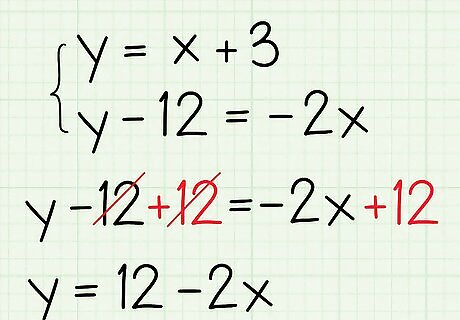
Write the equation for each line with y {\displaystyle y} y on the left side. If necessary, rearrange the equation so y {\displaystyle y} y is alone on one side of the equal sign. If the equation uses f ( x ) {\displaystyle f(x)} f(x) or g ( x ) {\displaystyle g(x)} g(x) instead of y {\displaystyle y} y, separate this term instead. Remember, you can cancel out terms by performing the same action to both sides. Start with the basic equation y = m x + b {\displaystyle y=mx+b} y=mx+b. If you do not know the equations, find them based on the information you have. Example: Your two lines are y = x + 3 {\displaystyle y=x+3} y=x+3 and y − 12 = − 2 x {\displaystyle y-12=-2x} y-12=-2x. To get y {\displaystyle y} y alone in the second equation, add 12 to each side: y = 12 − 2 x {\displaystyle y=12-2x} y=12-2x
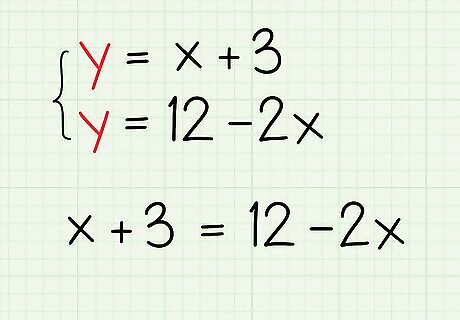
Set the right sides of the equation equal to each other. We're looking for a point where the two lines have the same x {\displaystyle x} x and y {\displaystyle y} y values; this is where the lines cross. Both equations have just y {\displaystyle y} y on the left side, so we know the right sides are equal to each other. Write a new equation that represents this. For example, if you want to know where the lines y = x + 3 crosses y = 12 - 2x, you'd equate them by writing x + 3 = 12 - 2x.
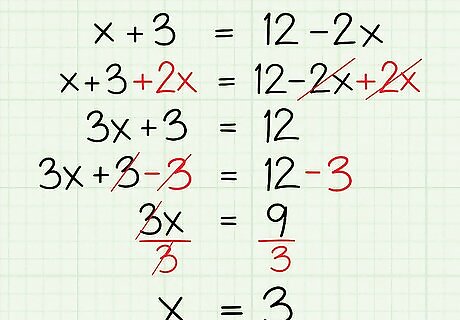
Solve for x. The new equation only has one variable, x {\displaystyle x} x. Solve this using algebra, by performing the same operation on both sides. Get the x {\displaystyle x} x terms on one side of the equation, then put it in the form x = ? ? {\displaystyle x=??} {\displaystyle x=??}. (If this is impossible, skip down to the end of this section.) Example: x + 3 = 12 − 2 x {\displaystyle x+3=12-2x} x+3=12-2x Add 2 x {\displaystyle 2x} 2x to each side: 3 x + 3 = 12 {\displaystyle 3x+3=12} 3x+3=12 Subtract 3 from each side: 3 x = 9 {\displaystyle 3x=9} 3x=9 Divide each side by 3: x = 3 {\displaystyle x=3} x=3.
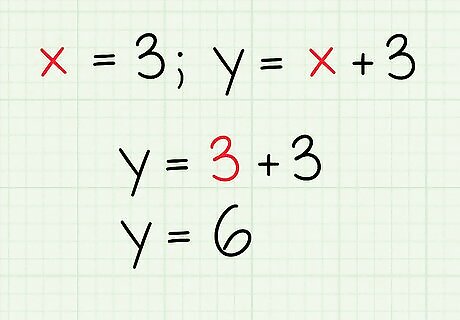
Use this x {\displaystyle x} x-value to solve for y {\displaystyle y} y. Choose the equation for either line. Replace every x {\displaystyle x} x in the equation with the answer you found. Do the arithmetic to solve for y {\displaystyle y} y. Example: x = 3 {\displaystyle x=3} x=3 and y = x + 3 {\displaystyle y=x+3} y=x+3 y = 3 + 3 {\displaystyle y=3+3} y=3+3 y = 6 {\displaystyle y=6} y=6
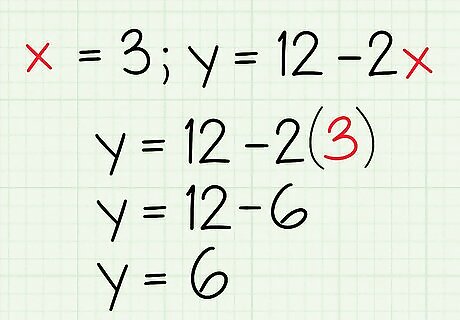
Check your work. It's a good idea to plug your x {\displaystyle x} x-value into the other equation and see if you get the same result. If you get a different solution for y {\displaystyle y} y, go back and check your work for mistakes. Example: x = 3 {\displaystyle x=3} x=3 and y = 12 − 2 x {\displaystyle y=12-2x} y=12-2x y = 12 − 2 ( 3 ) {\displaystyle y=12-2(3)} y=12-2(3) y = 12 − 6 {\displaystyle y=12-6} y=12-6 y = 6 {\displaystyle y=6} y=6 This is the same answer as before. We did not make any mistakes.

Write down the x {\displaystyle x} x and y {\displaystyle y} y coordinates of the intersection. You've now solved for the x {\displaystyle x} x-value and y {\displaystyle y} y-value of the point where the two lines intersect. Write down the point as a coordinate pair, with the x {\displaystyle x} x-value as the first number. Example: x = 3 {\displaystyle x=3} x=3 and y = 6 {\displaystyle y=6} y=6 The two lines intersect at (3,6).
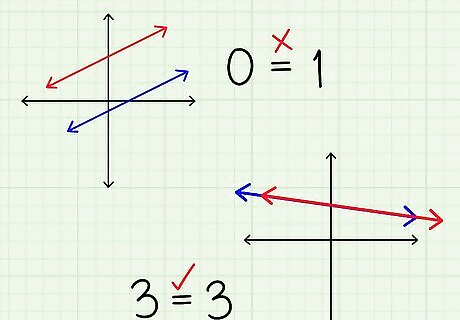
Deal with unusual results. Some equations make it impossible to solve for x {\displaystyle x} x. This doesn't always mean you made a mistake. There are two ways a pair of lines can lead to a special solution: If the two lines are parallel, they do not intersect. The x {\displaystyle x} x terms will cancel out, and your equation will simplify to a false statement (such as 0 = 1 {\displaystyle 0=1} 0=1). Write "the lines do not intersect" or no real solution" as your answer. If the two equations describe the same line, they "intersect" everywhere. The x {\displaystyle x} x terms will cancel out and your equation will simplify to a true statement (such as 3 = 3 {\displaystyle 3=3} 3=3). Write "the two lines are the same" as your answer.
Problems with Quadratic Equations

Recognize quadratic equations. In a quadratic equation, one or more variables is squared ( x 2 {\displaystyle x^{2}} x^{2} or y 2 {\displaystyle y^{2}} y^{2}), and there are no higher powers. The lines these equations represent are curved, so they can intersect a straight line at 0, 1, or 2 points. This section will teach you how to find the 0, 1, or 2 solutions to your problem. Expand equations with parentheses to check whether they're quadratics. For example, y = ( x + 3 ) ( x ) {\displaystyle y=(x+3)(x)} y=(x+3)(x) is quadratic, since it expands into y = x 2 + 3 x . {\displaystyle y=x^{2}+3x.} y=x^{2}+3x. Equations for a circle or ellipse have both an x 2 {\displaystyle x^{2}} x^{2} and a y 2 {\displaystyle y^{2}} y^{2} term. If you're having trouble with these special cases, see the Tips section below.
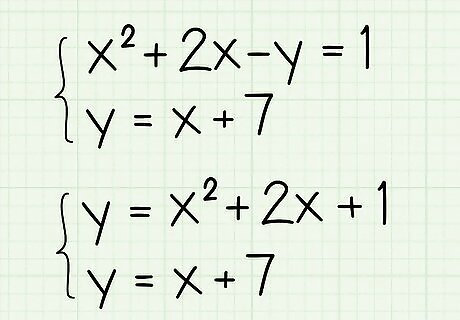
Write the equations in terms of y. If necessary, rewrite each equation so y is alone on one side. Example: Find the intersection of x 2 + 2 x − y = − 1 {\displaystyle x^{2}+2x-y=-1} x^{2}+2x-y=-1 and y = x + 7 {\displaystyle y=x+7} y=x+7. Rewrite the quadratic equation in terms of y: y = x 2 + 2 x + 1 {\displaystyle y=x^{2}+2x+1} y=x^{2}+2x+1 and y = x + 7 {\displaystyle y=x+7} y=x+7. This example has one quadratic equation and one linear equation. Problems with two quadratic equations are solved in a similar way.

Combine the two equations to cancel out the y. Once you've set both equations equal to y, you know the two sides without a y are equal to each other. Example: y = x 2 + 2 x + 1 {\displaystyle y=x^{2}+2x+1} y=x^{2}+2x+1 and y = x + 7 {\displaystyle y=x+7} y=x+7 x 2 + 2 x + 1 = x + 7 {\displaystyle x^{2}+2x+1=x+7} x^{2}+2x+1=x+7
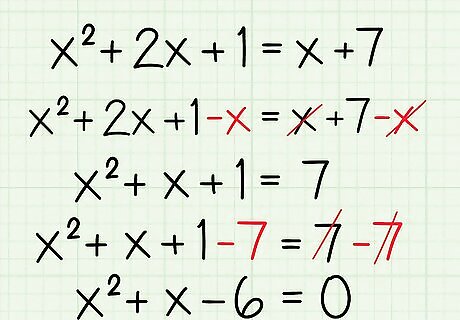
Arrange the new equation so one side is equal to zero. Use standard algebraic techniques to get all the terms on one side. This will set the problem up so we can solve it in the next step. Example: x 2 + 2 x + 1 = x + 7 {\displaystyle x^{2}+2x+1=x+7} x^{2}+2x+1=x+7 Subtract x from each side: x 2 + x + 1 = 7 {\displaystyle x^{2}+x+1=7} x^{2}+x+1=7 Subtract 7 from each side: x 2 + x − 6 = 0 {\displaystyle x^{2}+x-6=0} x^{2}+x-6=0
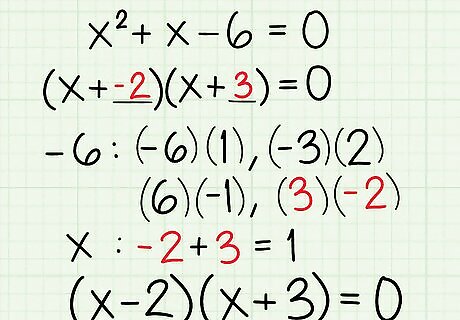
Solve the quadratic equation. Once you've set one side equal to zero, there are three ways to solve a quadratic equation. Different people find different methods easier. You can read about the quadratic formula or "completing the square", or follow along with this example of the factoring method: Example: x 2 + x − 6 = 0 {\displaystyle x^{2}+x-6=0} x^{2}+x-6=0 The goal of factoring is to find the two factors that multiply together to make this equation. Starting with the first term, we know x 2 {\displaystyle x^{2}} x^{2} can divide into x, and x. Write down (x )(x ) = 0 to show this. The last term is -6. List each pair of factors that multiply to make negative six: − 6 ∗ 1 {\displaystyle -6*1} -6*1, − 3 ∗ 2 {\displaystyle -3*2} -3*2, − 2 ∗ 3 {\displaystyle -2*3} -2*3, and − 1 ∗ 6 {\displaystyle -1*6} -1*6. The middle term is x (which you could write as 1x). Add each pair of factors together until you get 1 as an answer. The correct pair of factors is − 2 ∗ 3 {\displaystyle -2*3} -2*3, since − 2 + 3 = 1 {\displaystyle -2+3=1} -2+3=1. Fill out the gaps in your answer with this pair of factors: ( x − 2 ) ( x + 3 ) = 0 {\displaystyle (x-2)(x+3)=0} (x-2)(x+3)=0.
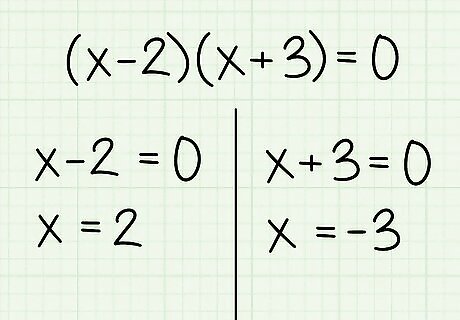
Keep an eye out for two solutions for x. If you work too quickly, you might find one solution to the problem and not realize there's a second one. Here's how to find the two x-values for lines that intersect at two points: Example (factoring): We ended up with the equation ( x − 2 ) ( x + 3 ) = 0 {\displaystyle (x-2)(x+3)=0} (x-2)(x+3)=0. If either of the factors in parentheses equal 0, the equation is true. One solution is x − 2 = 0 {\displaystyle x-2=0} x-2=0 → x = 2 {\displaystyle x=2} x=2. The other solution is x + 3 = 0 {\displaystyle x+3=0} x+3=0 → x = − 3 {\displaystyle x=-3} x=-3. Example (quadratic equation or complete the square): If you used one of these methods to solve your equation, a square root will show up. For example, our equation becomes x = ( − 1 + 25 ) / 2 {\displaystyle x=(-1+{\sqrt {25}})/2} x=(-1+{\sqrt {25}})/2. Remember that a square root can simplify to two different solutions: 25 = 5 ∗ 5 {\displaystyle {\sqrt {25}}=5*5} {\sqrt {25}}=5*5, and 25 = ( − 5 ) ∗ ( − 5 ) {\displaystyle {\sqrt {25}}=(-5)*(-5)} {\sqrt {25}}=(-5)*(-5). Write two equations, one for each possibility, and solve for x in each one.
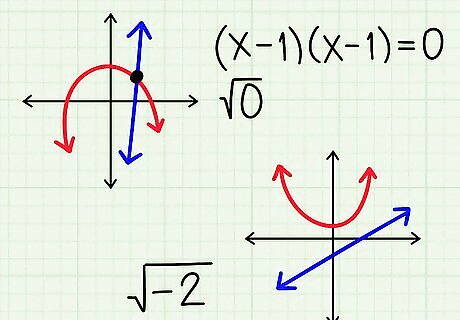
Solve problems with one or zero solutions. Two lines that barely touch only have one intersection, and two lines that never touch have zero. Here's how to recognize these: One solution: The problems factor into two identical factors ((x-1)(x-1) = 0). When plugged into the quadratic formula, the square root term is 0 {\displaystyle {\sqrt {0}}} {\sqrt {0}}. You only need to solve one equation. No real solution: There are no factors that satisfy the requirements (summing to the middle term). When plugged into the quadratic formula, you get a negative number under the square root sign (such as − 2 {\displaystyle {\sqrt {-2}}} {\sqrt {-2}}). Write "no solution" as your answer.
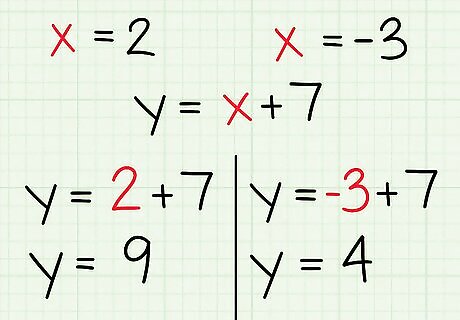
Plug your x-values back into either original equation. Once you have the x-value of your intersection, plug it back into one of the equations you started with. Solve for y to find the y-value. If you have a second x-value, repeat for this as well. Example: We found two solutions, x = 2 {\displaystyle x=2} x=2 and x = − 3 {\displaystyle x=-3} x=-3. One of our lines has the equation y = x + 7 {\displaystyle y=x+7} y=x+7. Plug in y = 2 + 7 {\displaystyle y=2+7} y=2+7 and y = − 3 + 7 {\displaystyle y=-3+7} y=-3+7, then solve each equation to find that y = 9 {\displaystyle y=9} y=9 and y = 4 {\displaystyle y=4} y=4.
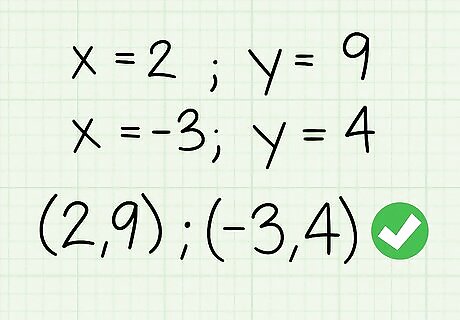
Write the point coordinates. Now write your answer in coordinate form, with the x-value and y-value of the intersection points. If you have two answers, make sure you match the correct x-value to each y-value. Example: When we plugged in x = 2 {\displaystyle x=2} x=2, we got y = 9 {\displaystyle y=9} y=9, so one intersection is at (2, 9). The same process for our second solution tells us another intersection lies at (-3, 4).



















Comments
0 comment